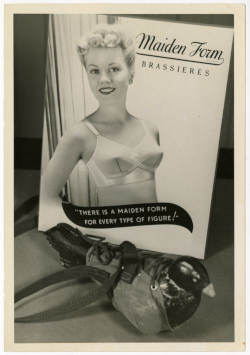
During World War II homing pigeons were the least likely
form of communication to be intercepted. More than 95% of the messages
they carried were successfully delivered. Due to their obvious necessity
for wartime communication, approximately 56,000 carrier pigeons were
trained for war missions in World War II. This was the height of carrier
pigeon use. Pigeons were parachuted behind enemy lines in specially
designed crates, but also with paratroopers. The pigeons were attached to
their chests with a bra. Yes, a bra designed by Maidenform.
Maidenform, switching, as many companies did from peacetime production to
producing necessary supplies for the war, on December 22, 1944
designed and contracted to make 28,500 pigeon vests. Complete design
details and photos are maintained and were supplied here by
the Smithsonian.
 |
 |
 |
 Now Pigeons serve With U. S. Paratroopers: Dropped in wire
baskets or strapped to soldiers' chests. Carrier pigeons fly messages back
to headquarters when radio or runners cannot be used.
Now Pigeons serve With U. S. Paratroopers: Dropped in wire
baskets or strapped to soldiers' chests. Carrier pigeons fly messages back
to headquarters when radio or runners cannot be used.
ARMY mule! Army dog! And now-army paratrooper pigeon! Yes,
pigeons that drop by parachute or pigeons strapped to the chests of
soldiers jumping from planes-that is the latest wrinkle in America's
fighting forces. Mule, dog, and now pigeon! Each has its place of service
in the battle for the preservation of the American way of life, because
Yankee resourcefulness and ingenuity have found a way to recruit even
animal life in war time. One wonders whether the family cat will next be
called on to serve its country, too. Perhaps it is already doing just
that. Pigeons have been used as army couriers as far back as the days of
the ancient Greeks and Persians, but now the birds travel in jeep-pulled
pigeon cotes and in airplanes. Employed as a means of communication by the
U. S. Army Signal Corps the feathered messengers serve along with radio,
telephone, semaphore, and wig-wagging Two paratroopers in every class are
now be-ing intensively trained as pigeoneers at Fort Benning, Ga. They
must learn how to care for the-pigeons, how to handle them in combat, how
to prepare tiny maps and brief messages to be attached to the legs of the
birds before they are released to fly their way through the hell of battle
back to their home pigeon loft. Although the infantry, the naval "blimps,"
and other branches of the armed forces use the pigeons, they are
especially helpful to the paratroopers. In most cases, use of radio or
runners is "out" when the paratroopers land behind the enemy lines. The
birds offer the only way to get information back to headquarters quickly.
Paratroopers are taught to jump with two of the pigeons strapped to their
chests. The birds are wrapped in khaki "jackets" for protection against
wing injury. And they are also dropped by parachute from planes and are
then picked up by the paratroopers. The container is a wire and canvas
basket, holding four or more birds, and is hung under the eight-foot
parachute. When picked up, the pigeons are placed in portable carrying
cases, by the paratroopers. Supplies for the pigeons for several days are
taken along.
Formerly an aluminum capsule was used to contain the message to be sent
back by the winged messenger. Now, however, a plastic case lighter than
aluminum is used. And this permits the sending of larger pieces of paper
with messages. Combat conditions to the present time have permitted more
extensive use of pigeons by the infantry than by the paratroopers. And
already the Signal Corps has begun to record the work of the pigeons.
When American troopers stormed and reconquered Gafsa,
Tunisia, "Yank," Signal Corps pigeon, was released with the message of
victory. He flew back to headquarters at Tebessa, Algeria, 98 miles, in an
hour and fifty-two minutes, to deliver the news ahead of all other means
of communication. "Yank" has a serial number, (A.S.N. 873) just like all
soldiers. In combat areas, 96 out of 100 pigeons "get through." The Signal
Corps pigeons are usually the darker feathered birds rather than the white
ones. The lighter birds are easy "hawk bait."
 Yank.
The pigeon that carried to headquarters the news of capute of Gafsa, in
the Tujnisian campaing.
Yank.
The pigeon that carried to headquarters the news of capute of Gafsa, in
the Tujnisian campaing.
Another reason for not using the white pigeons is that their plumage
quickly "goes bad" in the tropics. The pigeon has a life expectancy of 14
to 15 years. The birds used are bred from veterans in the service who have
been top-notch fliers for eight years of their career, and whose pedigreed
racers have intelligence and stamina. Speed is considered less important.
All pigeons are fast on the wing. Some have been known to cover 1,000
The pigeons have a quick maturity. They begin their training at four weeks
of age. They are seasoned fliers six months after birth. The night fliers
are reared in darkened mobile lofts and released in complete darkness

 |
 |
 |
 |
 |
 |
 |